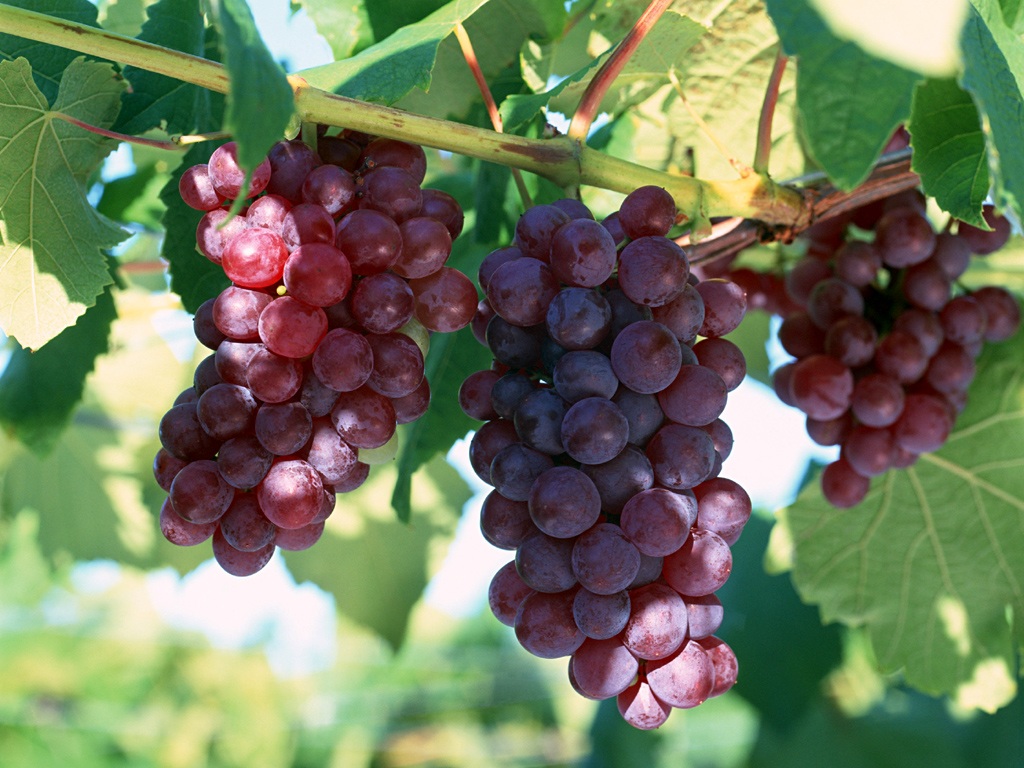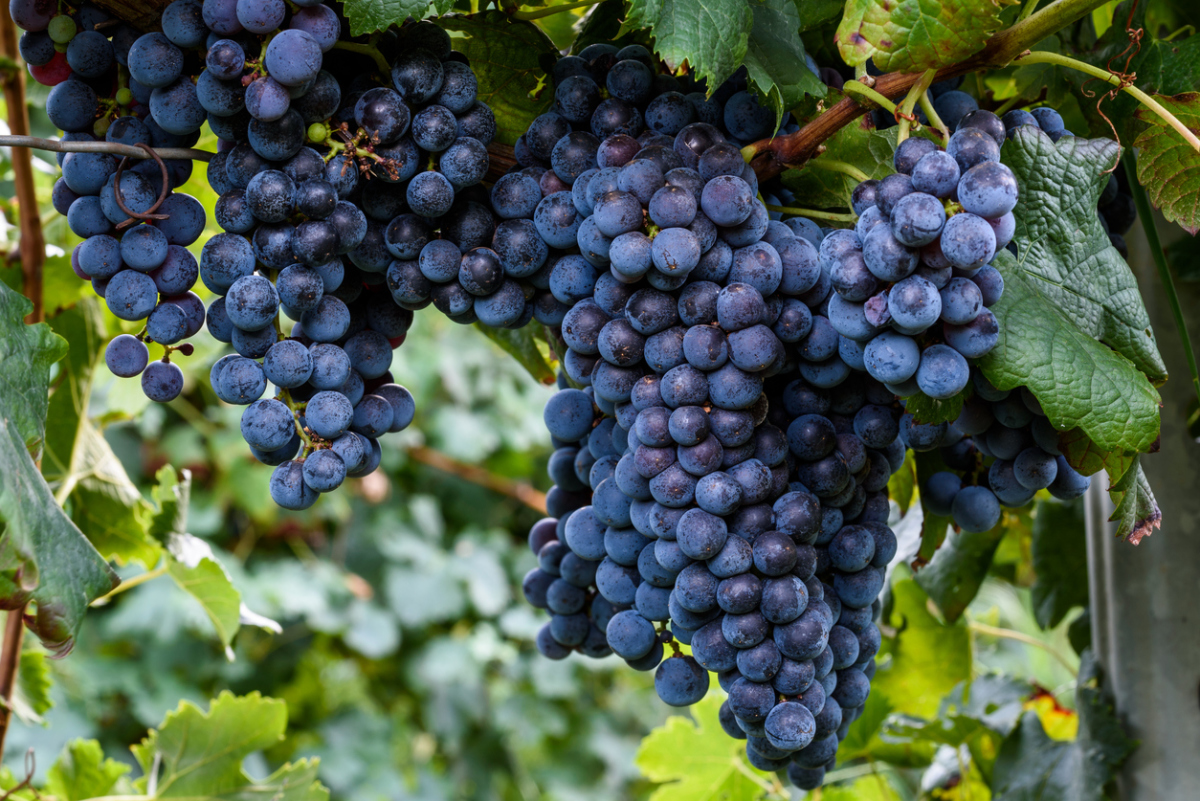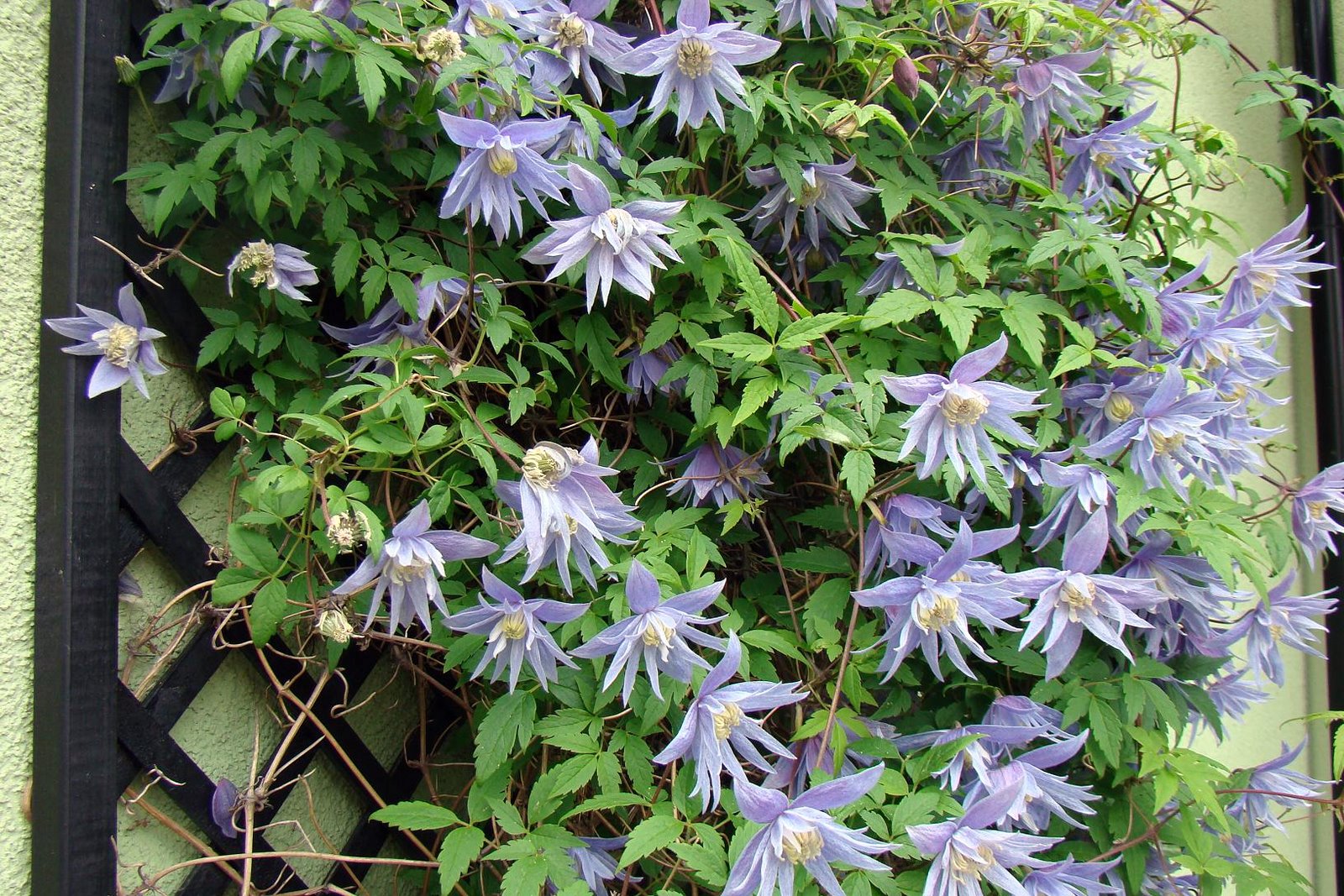Climbing garden vines belong to the type of plant that can be seen absolutely anywhere. In summer and spring, they decorate the walls of the facades with colorful flowers and green leaves. But in the fall they delight with yellow, brown or red leaves.
For simplicity, we divide the entire species diversity of lianas into two types:
- Annuals;
- Perennial.
All types have both decorative and fruit varieties. Consider the most popular varieties of vines for the garden in our latitudes and their photos, and start with climbing annual vines.
Content
Annual garden vines
There are quite a large number of annual vines for the garden, for example, decorative beans, morning glory, passionflower, and there are also more than a hundred other varieties. Along with the numerous differences in the appearance of these vines, there are also common features, for example, almost all have long stems, from which there are almost never side branches. Annual varieties are an excellent decoration for fences, terraces, balconies and any backyard area.
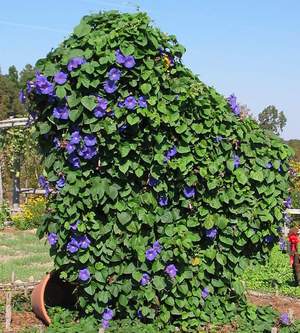 Curly annual vines should be planted in places where soil is often dug up. It must be a sunny place, vines need lighting for better development. The species diversity of these plants makes it possible to create various combinations. But you need to plant annuals every year and at the same time make sure that the scattered seeds of vines do not grow in unnecessary places, since plants can crowd out the rest of the nearby flowers.
Curly annual vines should be planted in places where soil is often dug up. It must be a sunny place, vines need lighting for better development. The species diversity of these plants makes it possible to create various combinations. But you need to plant annuals every year and at the same time make sure that the scattered seeds of vines do not grow in unnecessary places, since plants can crowd out the rest of the nearby flowers.
Landing vines you need to take care of the vertical supports, in the role of which branches laid in a pyramid, a fence, nets are suitable. The support must be not thick so that the plant stem can cling to it.
It is best to place the support already at the time of planting, since the support installed near the germinated plant can damage the roots. Since we are talking about annual vines, there is no need for insulation for the winter, and as for pruning, it is just necessary to remove the processes that clearly look superfluous.
Perennial garden vines
Now we will consider perennial garden vines, of which there are also a large variety, we will tell you about the most popular varieties, about their pruning, wintering, planting.
Climbing rose
 For its long flowering (from summer almost to the beginning of winter) and the rich color of the foliage, this vine is loved by many gardeners. Climbing rose blooms once a year, at the same time, it is quite abundant, on the liana you can always see a large number of inflorescences from already blossoming flowers and buds awaiting their turn.
For its long flowering (from summer almost to the beginning of winter) and the rich color of the foliage, this vine is loved by many gardeners. Climbing rose blooms once a year, at the same time, it is quite abundant, on the liana you can always see a large number of inflorescences from already blossoming flowers and buds awaiting their turn.
The place for climbing rose you need to choose in an area well-lit by the sun, a reliable support should be located near it, preferably wooden, so that the vine does not freeze during frosts.
And winter is a great test for this plant, since the plant is not adapted to our frosts. Therefore, you need to wrap it up well for the winter, in order to preserve the shoots, since without them you simply cannot see flowers in spring. The creeper root is insulated with sawdust, and individual branches are wrapped in non-woven material.
After the end of the frost, dry branches are cut off, and once every 3 years the plant must be thinned out to make room for new shoots.
Campsis
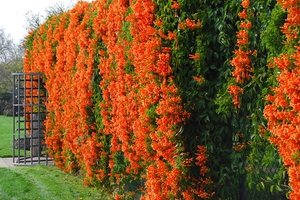 This is an interesting liana, it has amazing flowers that look like a gramophone trumpet, with which bright green leaves are perfectly combined. Plant tolerates frost wellalthough after winter it “wakes up” for quite a long time, for this the Kampsis is also called “the sleeping beauty”. The creeper blooms all summer.
This is an interesting liana, it has amazing flowers that look like a gramophone trumpet, with which bright green leaves are perfectly combined. Plant tolerates frost wellalthough after winter it “wakes up” for quite a long time, for this the Kampsis is also called “the sleeping beauty”. The creeper blooms all summer.
Campsis is a surprisingly unpretentious liana that does not need care, except for direct planting, since the plant may not take root and dry out. But, there is no need to rush to cut a seemingly dry seedling, the bush can suddenly "come to life", since its adaptation time can sometimes be quite long, as after winter. The established bush grows quickly, and can grow up to 10 meters in the first few years, and after 5 years, growth from the root begins, so it is advisable to plant the campis in a separate flower bed or in a fenced off place to limit the extensive growth of the root system.
Campsis is a heavy plant, therefore it needs a reliable support, by the way, its small roots stick well to the wall. Mowing this bush is not required at all, only you need to make sure that the place where the plant is located does not turn into an impassable thicket.
Actinidia
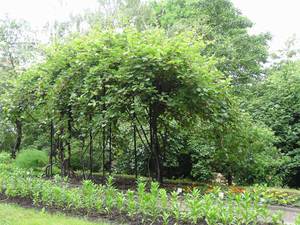 Actinidia is a powerful perennial flowering vine. It is unpretentious to care for, it is pleasant to look at it all the time, in the spring - at the abundant bright green foliage, which becomes burgundy red by autumn, and in winter orange berries appear on the plant.
Actinidia is a powerful perennial flowering vine. It is unpretentious to care for, it is pleasant to look at it all the time, in the spring - at the abundant bright green foliage, which becomes burgundy red by autumn, and in winter orange berries appear on the plant.
This vine is unpretentious to the quality of the soil, but loves good lighting. Her best plant near the northeastern wall of a fence or house... In a plant planted in the northern area, flowering begins later, the buds also appear late, which is protection from spring frosts.
Actinidia overwinters with ease if, during flowering and fruiting, it is provided with proper care, the main thing in which is good watering.
Pruning of the plant must be carried out at the appropriate time, and has 2 periods:
- During flowering, as soon as it fades.
- After falling foliage.
Young actinidia is pruned so as to create a beautiful appearance for it; for this, most of the shoots are pruned, leaving several of the strongest ones. In the future, pruning is reduced to pruning dry and weak shoots.
Wild grapes
 Perfectly clings to trees, fences and walls, because wild grapes are often planted for vertical landscaping, they are quite picturesquely braids the surface with foliage, by autumn the green leaves turn red over time, which looks very beautiful.
Perfectly clings to trees, fences and walls, because wild grapes are often planted for vertical landscaping, they are quite picturesquely braids the surface with foliage, by autumn the green leaves turn red over time, which looks very beautiful.
Wild grapes will perfectly take root almost anywhere, as long as there is a support nearby where it can weave. At the same time, the support must be quite strong and stable, the weight of the vine is very large. As a rule, reinforcement, nets or ropes are used as support.
By winter on this plant only bunches of berries remain, all the foliage falls off... It so happens that some shoots freeze under severe frosts, but this is not fatal, since new ones will soon grow from the root.
The plant does not require special care, pruning is carried out in those places in which the overgrown shoots are no longer in place. It is necessary to ensure that young grapes, which sprouted in spring from fallen seeds, do not fill the entire territory, displacing the rest of the plantings.
Honeysuckle
There are different varieties of honeysuckle, some varieties do not bloom, others bloom in the garden, emitting pleasant smells, the fruits of certain varieties of honeysuckle can be used for food... The buds of this plant open in the evening and their scent attracts butterflies.
The plant is undemanding to the composition of the soil, but it develops better on sandy loam and loamy soil, loves good lighting. Rarely susceptible to disease, many pests for honeysuckle are not terrible.Young shoots can freeze, although, in general, the plant tolerates winter normally... It is good when, for the winter, the shoots are under deep snow or fallen leaves. Before winter, it is advisable to remove the young bush from the support, and the old shoots are covered with non-woven material and fixed with wire. By and large, insulation is not necessary for a two-year-old plant, only that with large frosts there is a threat of icing.
The best time for pruning bushes is the end of autumn, pruning is carried out according to the thinning principle, the old crown is cut off, and shoots that lie directly on the ground are also cut off.

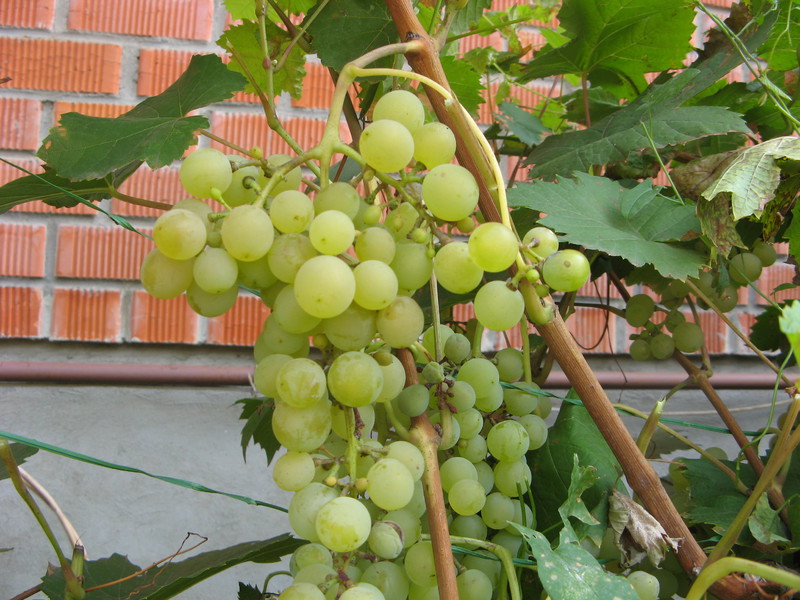


Grapes
Probably everyone knows the vine with its rich green foliage. After flowering, berries appear on the shoots, changing color over time from green to burgundy and black... In winter, all the foliage from the plant falls off, only stiff lashes remain, which in the spring will again be covered with leaves and shoots.
The best place for planting grapes is near the wall of the house, where grapes grow and begin to weave. Another option is to put the plant on the pergola, in this case the grapes can be used as a decoration for the gazebo. Planted best in the western area, which is illuminated by the sun at the end of the day.
Grapes in our conditions have the ability to freeze out, in order to prevent this, it you need to water well in summer, and prune weak branches in time... You also need to insulate the grapes before winter, covering the roots with spruce branches or sawdust.
Pruning is done in order to increase the yield and to form a lush crown. Pruning methods will depend on the specific grape variety and area where it is grown, and it is best to consult with experienced gardeners to get the correct pruning.
Ivy
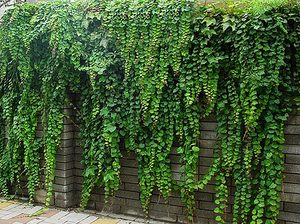 This is almost the most popular perennial climbing liana. The abundant lush green foliage of this plant creates an impenetrable carpet, but it almost never has flowers, especially in our climate.
This is almost the most popular perennial climbing liana. The abundant lush green foliage of this plant creates an impenetrable carpet, but it almost never has flowers, especially in our climate.
Ivy is not the most ideal choice for a garden, although it is an unpretentious plant, but in winter it can freeze completely, and in summer it can burn out under the hot sun... However, in many gardens you can see walls completely covered with ivy. By the way, with the same effect, the plant can be planted as a lawn covering.
For ivy, you need to choose a well-lit and windless place. When planting a bush near a wall so that it covers it, it is necessary to timely build a support for it in the form of stretched ropes or crate. The first time you need to tell the ivy in which direction to grow, and then it will continue to attach itself.
This plant hibernates without throwing off foliage, which is replaced in spring. Pruning is done in relation to shoots that go beyond the limits assigned to the plant.
Clematis
 This plant blooms very beautifully, the petals in appearance can be of different colors, which you can choose yourself when buying a bush. The inner petals are completely white, the tips are the same color as the leaves.
This plant blooms very beautifully, the petals in appearance can be of different colors, which you can choose yourself when buying a bush. The inner petals are completely white, the tips are the same color as the leaves.
Not to say that this plant is demanding on germination conditions, but still it feels better in a sunny area. The main thing that the roots were closed, further care is not needed... To make it easier for the liana to trail, it is best to immediately build a fabric mesh on a reliable support. The bush's clues are its leaves, which it creeps upward.
Clematis tolerates winter well, throwing off foliage and remaining only with thin, dried shoots. With the arrival of spring, it comes to life, becomes covered with leaves and begins to bloom.
Florists recommend pruning clematis when it reaches the size of human growth, taking into account the plant variety, there are some nuances associated with pruning, therefore it is best to consult with specialists.
Wisteria
 Wisteria grows in the southern regions. It is somewhat similar to kampsis, especially with feathery leaves of bright green color and a thick stem.A particularly attractive type of wisteria is in bloom, the inflorescences of this plant can be of various colors - blue, pink, white, purple, and so thick that no leaves or branches are even visible.
Wisteria grows in the southern regions. It is somewhat similar to kampsis, especially with feathery leaves of bright green color and a thick stem.A particularly attractive type of wisteria is in bloom, the inflorescences of this plant can be of various colors - blue, pink, white, purple, and so thick that no leaves or branches are even visible.
The whimsicality of the liana does not refer to the ground, but to the climatic location, wisteria needs an area without wind, well warmed by the sun... On the site where this plant will be, water should not accumulate, otherwise in winter this will lead to icing of the branches and freezing of the soil, which will certainly destroy the bush.
As a support, it is best to use a metal or wooden pergola, while the support must be made reliable, since the wisteria has powerful branches and, growing, the plant gains significant weight. Wisteria pruning is done twice a year.
- In the fall, young shoots are cut in half.
- In the summer, at the beginning of August, all shoots are cut back to two-thirds of the length.
Pruning will encourage more buds in the coming year.
We have told you only about a few of the most popular varieties of vines for the garden, probably this can help you make the right choice, but do not forget that there are many other types of climbing plants, so there is plenty to choose from.
